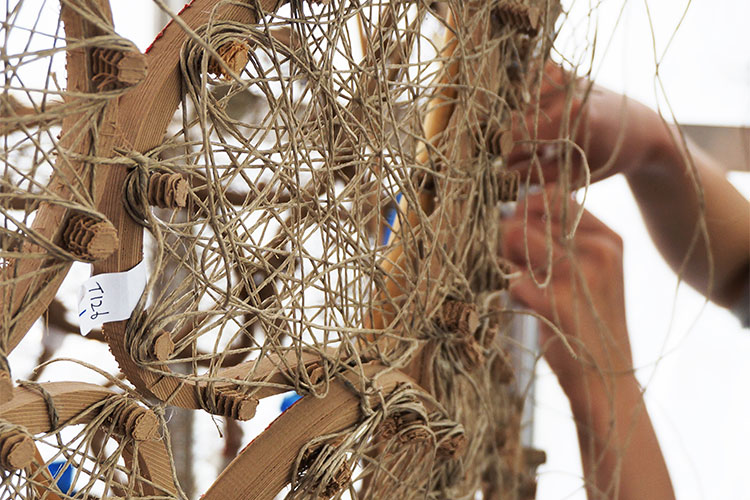Botanical Garden hosts giant bird’s nest built with natural fiber, digital tools
Graduate students in architecture work with associate professor M. Paz Gutierrez aim big as they begin to unravel the elaborate construction secrets of the weaver bird

May 23, 2017
The University of California Botanical Garden is home to hundreds of bird’s nests, tucked into plants covering the 34-acre site in Strawberry Canyon. And for the next few days, it is home to one more: a giant pendant resembling an oversized weaver bird nest, constructed with a 3D scanner, a modified 3D printer-turned-weaver, wood waste, hemp fiber and human hands.

Graduate student Lerena Zhao reaches up to touch the rim of the gigantic replica of a weaver bird’s nest. (UC Berkeley photo by Hulda Nelson.)
Graduate students in a class led by UC Berkeley associate professor of architecture M. Paz Gutierrez worked for the past two semesters to produce the stunning brown orb made of all natural materials that is hanging in the Botanical Garden’s conference center through Thursday, May 25.
“Plant Fiber Enclosure: Origins” is a simple name for a complex object. It weighs about 20 pounds and is made from 400 woven pieces of varying sizes and designs inspired by the lightweight weaver bird’s nest, known to be the most elaborate of any bird, with intricate curvatures as well as superior insulation, acoustics and strength.
“It’s gorgeous,” said Botanical Garden director Eric Siegel.
Gutierrez, whose work focuses on developing radically new, sustainable building technologies and connecting them with traditional construction and fabrication, stresses that the installation is much more than a copy of a natural object.
Instead, she said, it offers a means to learn more about the construction processes and the material and social dynamics of nest building. She said it also is a step toward understanding more about how traditional and sustainable construction can be adapted to accommodate the demands, limited resources, changing climates and emerging digital technologies of the modern world.
“It’s opening new paths for research in this area,” said Gutierrez.
Her current research spans many locales and orientations, and the weaver bird research relates most closely to her ongoing work involving manufacturing and agricultural waste construction in remote areas such as the western Amazon, where natural materials are often replaced by less environmentally friendly concrete and metal.
Students working with Gutierrez did a 3D scan of weaver bird nests to discern patterns of looping and netting construction design principles to produce a model and associated algorithms. Then they re-engineered a 3D printer to use hemp and wood waste instead of plastics or liquids, and installed robotic weaving “arms” on the printer programmed to thread the hemp fibers just so.
Siegel said the installation is one more example of meaningful research conducted at the garden above the central campus and connections between the garden and UC Berkeley research.
Gutierrez and Siegel met at a campus presentation about her work, and he invited her to speak in March at the garden’s long-running series about plant fibers and dyes. When he learned of her weaver bird’s nest project, the garden seemed a natural fit.
Deepa Natarajan, the garden’s program coordinator, worked with the team to identify the installation site and to support the students during the installation. An ethnobotanist with expertise in fabrics and dyes made from plants, the project resonated with Natarajan. “Fiber Enclosure: Origins” was woven in segments at UC Berkeley’s College of Environmental Design and finally assembled by students in the garden’s conference center in two days.
However, the conference room site will be turned over for summer programming late next week and future venues are under discussion.
Gutierrez, a native of Chile, is the recipient of research grants from the National Science Foundation, the U.S. Department of Energy and the Environmental Protection Agency. In 2008, she founded a new interdisciplinary research initiative called BIOMS (www.bioms.info), which brings together architecture and sciences such as bioengineering to integrate principles of both design and biophysics.
The garden is open from 9 a.m. to 5 p.m. Directions are available online.












